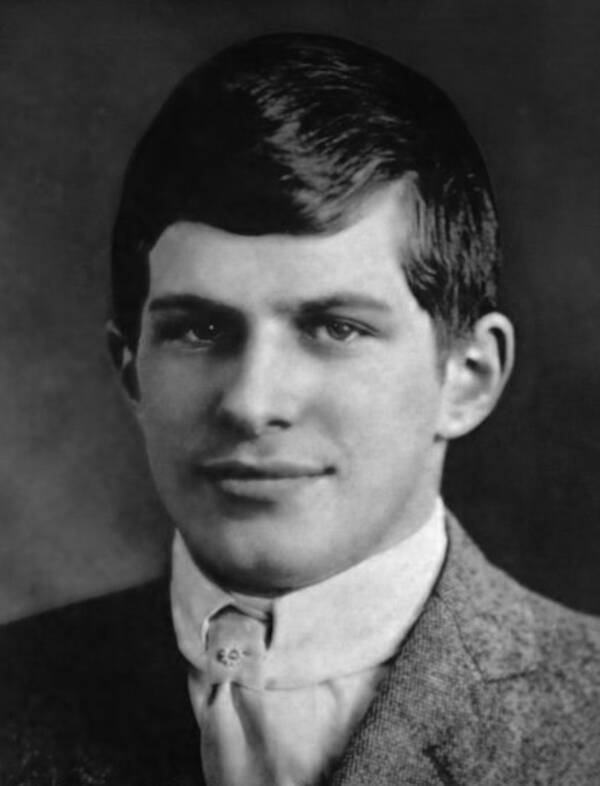
The most intelligent person to ever live was born in America in 1898. William James Sidis was his name, and he eventually had an IQ score that ranged between 250 and 300. (with 100 being the norm).
His parents, Boris and Sarah, had good minds of their own. Sarah worked as a doctor, and Boris was a well-known psychotherapist. Some accounts claim that the Ukrainian immigrants settled in New York City, while others identify Boston as their hometown.

In each case, the parents were proud of their talented boy and lavished financial resources on books and maps to support his early education. Yet they were unaware of how quickly their beloved toddler would catch on.
A Genuine Young Prodigy
William James Sidis was able to read The New York Times when he was just 18 months old.
He could speak English, French, German, Russian, Hebrew, Turkish, and Armenian by the time he was six years old.

Sidis created his own language as a child, which is even more impressive (though it’s unknown if he ever used it as an adult). The aspirational child also wrote a novel, poetry, and even a proposed constitution for an eventual utopia.
At the tender age of nine, Sidis got accepted to Harvard University. He couldn’t enroll in classes, though, until he was eleven.
He gave a speech to the Harvard Mathematical Club in 1910 when he was still a student on the exceedingly difficult subject of four-dimensional bodies. For the majority of the audience, the talk was nearly incomprehensible, but for those that did, the lesson was a revelation.
Sidis earned his degree from the renowned institution in 1914. He was 16 at the time.
William James Sidis’ Unparalleled Intelligence

As there are no known records of William Sidis having his IQ tested, historians of today are left to guess as to what it might have been.
For comparison, an IQ score of 100 is regarded as average, while one of less than 70 is frequently seen as low. Anything over 130 is regarded as exceptionally gifted or advanced.
Reverse-analysis of historical IQs has revealed that Albert Einstein had a 160 IQ, Leonardo da Vinci had a 180 IQ, and Issac Newton had a 190 IQ.
William James Sidis’ IQ was reportedly between 250 and 300.
Every intelligent person will be pleased to inform you that it has no meaning (though they will probably still be a little cocky about it). Yet, Sidis was so intelligent that his IQ was equal to that of three typical people put together.
Nonetheless, despite his intelligence, he had trouble blending in with a society that didn’t comprehend him.
At age 16, after he received his Harvard diploma, he declared to reporters, “I want to live the perfect life. Living in seclusion is the only way to lead the ideal existence. I’ve never liked crowds.
The boy wonder’s strategy succeeded about as well as you might expect, especially for someone who had been so well-known for such a long time.
He briefly served as a mathematics instructor at Houston, Texas’ Rice Institute. But he was nearly driven out, in part because he was younger than many of his pupils.
The smartest person in the world passes away quietly rather than with a bang.
When William Sidis was detained during a Boston May Day Socialist March in 1919, he temporarily courted controversy. He had committed neither of the crimes for which he had been given an 18-month prison sentence: rioting nor assault on a police officer.
After his run-in with the law, Sidis was resolved to live in peace and alone. He took on a number of low-paying occupations, like entry-level accounting. Yet as soon as he was identified or his coworkers found out who he was, he would leave right away.
He later complained, “The very sight of a mathematical formula makes me physically uncomfortable.” They won’t let me be alone, even if all I want to do is run an adding machine.
Sidis made his final appearance in the public eye in 1937 when The New Yorker published a dismissive story about him. He chose to file a lawsuit for malicious libel and violation of privacy, but the judge

The history of Flour sack clothing fashion
After Kansas mill owners found women reused flour sack materials into apparel in the 1920s and 1930s, they started applying patterned designs to give families with more fashionable patterns and material.

Franz Ferdinand’s Assassination that sparked World War I
Archduke Franz Ferdinand of Austria and his wife Sophie are shot to death by a Bosnian Serb nationalist during an official visit to the Bosnian capital of Sarajevo on June 28, 1914. The killings sparked a chain of events that led to the eruption of World War I by early August.

Thomas Baker's heroic act that earned him the "Medal of Honor" was 8 bullets until death
Thomas Baker instructed his team to leave him with a pistol and eight bullets propped up against a tree after he was injured. Later, American troops discovered the now-deceased Baker in the same location, lying next to eight dead Japanese soldiers and carrying an empty pistol.

History of Treadmill, punishment for prisoners
Treadmills were originally a punishment used to harness human power on a giant wheel used to grind grains, hence the name "treadmill." The History of Treadmill

Medieval Medicine: A 1,000-year-old onion and garlic salve kills modern bacterial superbugs
Scientists recreated an Anglo-Saxon manuscript-based 9th century onion and garlic eye remedy and discovered that it killed 90% of antibiotic-resistant staph bacteria (MRSA).

Louis Le Prince Invented the motion picture camera, and then he mysteriously disappeared
Louis Le Prince, the inventor of motion pictures, vanished without a trace in 1890. Thomas Edison quickly claimed the title of "first and sole inventor of cinema," even taking Le Prince's son to court to dispute it. A few years later, the son also dies under mysterious circumstances.

Man's Blood Helped Save Millions of Babies
Australian blood donor James Harrison has been one of our most impressive and valued donors, having donated for 60 years. Know his story, how he was a pioneer of our Anti-D program, and why this matters.

Max Headroom Incident: America’s Creepiest TV Hack
In 1987 a man hijacked a television station during an episode of Dr. Who and wore a Max Headroom mask and uttered nonsense, and he still hasn’t been caught

How Greek prime minister in 1830’s tried to spread the potato in Greece
A Greek prime minister in 1830’s tried to spread the potato in Greece but people weren’t interested so he put armed guards in front of shipments of potatoes so people would think they were important. People later started stealing these potatoes a lot which spread the crop to all of Greece.

The Baltic Way: the longest unbroken human chain in history
On August 23, 1989, about 2 million people from Latvia, Estonia, and Lithuania formed a human chain that united all 3 countries to show the world their desire to escape the Soviet Union and the communism that brought only suffering and poverty. This power stretched 600 km.

Titanoboa cerrejonensis, fossils of the world’s largest species of snake
In 2009 in a coal mine of Columbia, scientists discovered fossils of the world’s largest species of snake. The species is called “Titanoboa cerrejonensis,“and it is from around 60 million years ago. It would have had measured about 48 feet long and weighed about 2,500 pounds

3 men lived on top of a billboard in tents for almost 9 months
From 1982-1983, three men in Allentown PA competed in a radio contest in which they lived on top of a billboard in tents. Whoever stayed up longest would win a house. Due to economic pressure from the recession, none of the contestants wanted to give up, so the contest lasted almost 9 months.

The unbroken seal on King Tutankhamun's tomb until 1922
The unbroken seal of Tutankhamun's tomb before it was opened in 1923, it was unbroken for over 3000 years.

Juliane Koepcke: The Teenager Who Fell 10,000 Feet And Trekked The Jungle to survive
In 1971, a high school student was sucked out of an airplane after it was struck by lightning. She fell 10,000 feet to the ground while still strapped to her chair and survived. Only to endure a 9-day trek to the nearest civilization.

Underground Railroad to Mexico freed thousands of slaves in 1829
Slavery was abolished in Mexico in 1829. Slaves were escaping to Mexico, and slaveholders in the US were aware of this. The US attempted to get Mexico to sign a fugitive slave treaty, which would have required Mexico to send back escaped slaves to the US. But, Mexico refused, arguing that slaves were free as soon as they set foot on Mexican soil.

The true story of Josephine Myrtle Corbin, the lady born with four legs and two private parts
Josephine Myrtle Corbin, an American sideshow performer born in 1868, had a rare condition known as dipygus, which caused her to have four legs, each smaller inner leg paired with one of her outer legs. Corbin joined the sideshow circuit, captivating audiences as the "Four-Legged Girl from Texas."

Quaker Oats Fed Children with Radioactive Oatmeal
In the 1940s and 1950s, Quaker Oats and MIT conducted experiments on radioactive iron and calcium-containing cereal. The diet was part of a study to see if the nutrients in Quaker oatmeal traveled throughout the body. In January 1998, a $1.85 million settlement was reached for 30 victims who came forward.

8 Interesting Facts About The Unsinkable Ship, TITANIC
If you ask your friends what's the most famous ship in history the answer in most cases will be the same, of course the legendary Titanic. Its history is full of mysteries, at first it was a source of hope and national pride as well as proof of the triumphs of mankind but it soon became a source of nostalgia and pain, the extent of which cannot be described in words.

Vince Coleman, a railway dispatcher, sacrificed his own life
Vince Coleman, a railway dispatcher, sacrificed his life in order to warn an incoming train of an imminent explosion. His telegraph said “Hold up the train. Ammunition ship afire in harbor making for Pier 6 and will explode. Guess this will be my last message. Good-bye, boys.” He saved 300 lives.

15 interesting facts about Queen Elizabeth II
Queen Elizabeth II, who ruled Britain for 70 years, has away at the age of 96. She was the country's longest-reigning monarch. Here are some little-known facts about her.

Nordlingen, The Town Inside A Meteorite Crater With Millions Of Meteorite Diamonds
The German town of Nördlingen is embedded with 72,000 tons of microscopic diamonds. About 15 million years ago, a meteorite hit this region, and the impact created a massive depression and formed rocks containing diamonds, glass, and crystals. The town was built in the impact crater sometime around 898 CE.

Ea-Nasir: world's oldest written customer complaint
This clay tablet, written in cuneiform, is the oldest known written customer complaint about the delivery of poor quality copper ingots. Originally from ancient Babylon, the tablet dates back to 1750 BCE, and it was written by a customer named Nanni to a merchant named Ea-Nasir. It is currently housed in the British Museum.

how Ferris wheel invented
In 1891, Chicago challenged engineers to create a structure to surpass the Eiffel Tower for the World's Columbian Exposition. George Washington Gale Ferris jr. responded with the original Ferris Wheel, a giant rotating structure elevating visitors above the city. This invention became an iconic attraction at the fair.

Nuclear bomb accidentally dropped on North Carolina in 196
4 January 1961: The 4241st Strategic Wing's Boeing B-52G-95-BW Stratofortress, serial number 58-0187, was on a 24-hour airborne alert mission off the United States' Atlantic Coast.

Nathan's Famous Doctor Stunt
When Nathan's Famous Hot Dogs first opened in 1916, the owner hired people to dress as doctors and eat hot dogs outside his shop, to convince people his hot dogs were healthy.



























